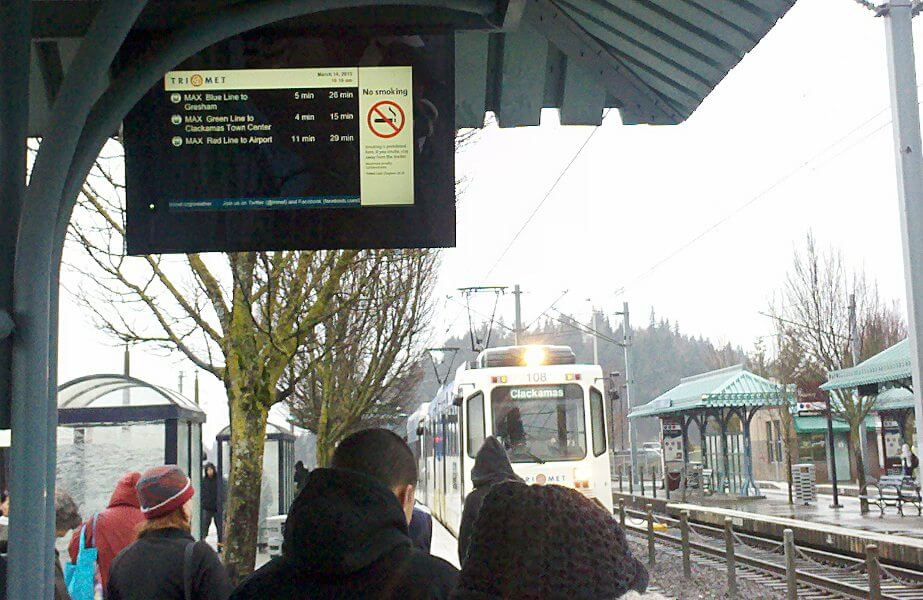Portland: subsidies attracted economic development, not LRT
- Reality Check
-
SkyTrain for Surrey press team
- March 15, 2012
There are serious problems with the City of Surrey’s use of Portland’s MAX Light Rail as an example to boost the image of potential at-grade Light Rail in Surrey, and one of those problems is the assumption that all of the apparently reported “$8 billion in development” near MAX Light Rail lines was legitimate development that was actually caused by Light Rail.
Dianne Watts, Mayor of Surrey
State of the City 2011 – Sheraton Guildford Hotel
City of Surrey
Official LRT plan page ("Rapid Transit Now")
First of all, it is very highly likely that the number that has been brought forward is seriously over-estimated. The problem with some of the claims of how many billions of dollars were spent on nearby development is that they are total numbers in the amounts of any type of development built nearby—there is no actual defined relation between this value and whether it was caused by transit or not.
A policy analysis by the Cato Intsitute[1] found that a vast majority of the $2.3 billion in investments (*under the assumed rule that any nearby development counts) that were supposedly stimulated by both the Portland Streetcar and Aerial Tram were for government buildings. These subsidies are also confirmed in several other sources we list [2][3][4][5][6][7]. Some were apparently built in response to executive orders by the U.S. President and Governor of Oregon that all federal and state agencies should relocate to downtown areas.
Randal O'Toole, The Cato Institute
Debunking Portland: The City That Doesn’t Work (2007 study)
But that might not be the biggest issue that comes to face; the truth is that most of the private developments themselves have been recipients of large subsidies. A commission called the Portland Development Commission (PDC) exists to use tax-increment financing and federal grants to help subsidize developments in urban-renewal areas.
Because many of those areas have been in the more recent years been focused on transit zones and corridors, it can be implied that those developments were recipients of PDC subsidies. In particular, for the $2.3 billion in development gathered by the Portland Streetcar and Aerial Tram in the downtown zones, at least $665 million in subsidies may have been granted through the PDC [1][2]. The larger-scale MAX Light Rail operations were also recipients of such large subsidies.
By 1996 the MAX Light Rail had been operating for 10 years, and some important city spokespersons had noticed the lack of the promised development that was expected to have come to the MAX line and area en masse by then.
Randal O'Toole, The Cato Institute
Debunking Portland: The City That Doesn’t Work (2007 study)
Charles Hales, Portland City Commissioner
statement at Portland City Council reported in The Oregonian, 1996
For comparison and contrast, after 10 years of operation of the Vancouver SkyTrain, important TOD-grown areas such as today’s Metropolis at Metrotown in Burnaby were well into their development phases. Development continues near there today, indicating continuously low vacancy rates, high demand and a continued need for expansion in that area. In contrast, Charles Hales was reporting that the majority of what had indeed been built near light rail in Portland was suffering from high vacancy rates.
Millions (billions?) of dollars spent to ensure construction of transit-oriented development
During the same year (1996), Commissioner Hales proposed to subsidize the development by offering developers of any high-density housing near light rail stations tax waivers. The Portland Housing Bureau has a page on the application process for these tax waivers (see [6]).
The development finally came, and it came at a huge expense. A boom in high-density developments overthrew Portland over the next 10 years – and virtually all of those developments were subsidized. An estimated $2 billion dollars of tax waivers (subsidies) may have been spent for the attraction of transit-oriented development near MAX Light Rail lines by the time those 10 years were up [1][2].
Millions (billions?) of dollars were being spent just to ensure the construction of transit-oriented development. These “incentives” have not been eliminated since then—and without them, little or no transit-oriented development would take place.
As much as 44% of some individual project costs were brought in through subsidies – with subsidies that, once again, may have been necessary in order to even ensure that such a project would even be brought forward. The example at footnote [3] is for a development that is located along the “Interstate Corridor Urban Renewal Area” – which is centred around the Interstate Ave. corridor which carrying the MAX Light Rail Yellow Line.
Other subsidized support dollars that came to developers (aside from the 10-year tax waivers) included infrastructure subsidies, below-market land sales, and direct grants from the Federal Transit Association, U.S. Department of Transportation.
Is light rail transit effective for attracting development at all?
One could argue that the tax waivers were not traditional subsidies in the sense that while the government wasn’t making taxes, the subsidies excluding taxes were not actually a cause of expense as they were waivers in revenues. However, that’s not the point….
The point is: It was these millions in dollars of subsidies and not light rail that brought on this new development. One could have also had these development-attracting subsidies and associated development without the expensive billion dollar investments in light rail.

In general, Light Rail has not been making the difference in Portland that we have come to expect and see. It might have to do with the relatively poor levels of service being provided and the substantially smal—if any—improvements that are coming at all from the construction of new MAX line extensions, with MAX lines travelling at an average speed of just 30km/h despite often paralleling freeways. Despite the billions spent on MAX, transit mode-share in Portland remains at a stand-still.
Surrey is not Portland, and the MAX Light Rail cannot serve as a role model for such similar future implementation here. Portland does not have to integrate its rail transit system with rail transit systems in other neighbouring cities, something that Surrey has to do. Surrey is both in a crunch in terms of fast-growing population and fast-growing expenditures; unsubsidized transit-oriented-development must be ensured.
The Portland MAX Light Rail, operated by the Tri-County Metropolitan Transportation District of Oregon (TriMet), should not be considered a good example for Surrey to follow. If the City of Surrey were really serious about the options and examples being considered and followed, then they shouldn’t be pursuing at-grade Light Rail and should be looking to other options.
References
The Cato Institute and Randal O’Toole – Debunking Portland: A City that Doesn’t Work – Data in Myths #2 (Transit-oriented development) and #3 (development-oriented transit), Pages 6 to 9 [LINK]Some examples – [Reference #78]
Noting that: the statements by Cato on Pgs. 6 to 9 regarding the presence of subsidization for LRT-related development were not effectively addressed in the comparison study “Debunking Cato: Why Portland Why Portland Works Better Than the Analysis of Its Chief Neo-Libertarian Critic” section II. Transit-Oriented Development on page 4, by Michael Lewyn of the Congress for the New Urbanism. [LINK]
Property Tax Exemption examples on Saveportland.org, with statements sourced from Portland City Council Agenda [LINK]
EcoFlats: One More Unsustainable Green Icon for Portland – Cascade Policy Institute [LINK]
Podobnik, Bruce. “Assessing the social and environmental achievements of New Urbanism: evidence from Portland, Oregon.” – [Reference #49]
“The Mythical World of Transit-Oriented Development.” Cascade Policy Institute. – [Reference #79]
Transit-Oriented Development (TOD) Property Tax Abatement – Portland Housing Bureau – [LINK]
HOUSING NEAR LIGHT RAIL GETS INCENTIVE – The Oregonian via Newsbank Archives (paid) [LINK]
About SkyTrain for Surrey
SkyTrain for Surrey is the community organization that advocated for the Surrey-Langley SkyTrain extension. From our beginnings as a petition calling for the scrapping of a street-level LRT proposal, we grew into a community of like-minded folk, taking on various projects such as making SkyTrain an election issue in 2018 as a registered advocacy group. SkyTrain for Surrey continues to call for high-quality transit infrastructure projects serving Surrey, Delta and the Langleys.
Media Contact:
Daryl Dela Cruz – Founder, SkyTrain for Surrey
Phone: +1 604 329 3529, [email protected]
Stay updated with the Surrey-Langley SkyTrain project team!
Be sure to subscribe to the Surrrey-Langley SkyTrain's mailing list (on the contacts page of the Surrey-Langley SkyTrain website) for official project updates! There is also now an official project email to get in touch with the planning team: [email protected].
